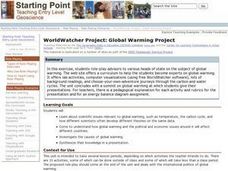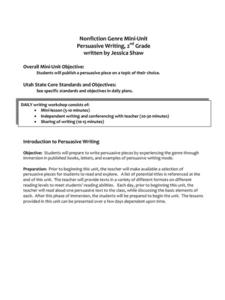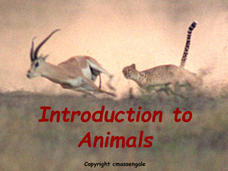Curated OER
Microclimates of Our School
Students read the story "Weslandia" by Paul Fleischman, define the term microclimate, gather and record data in various places on school grounds to establish the presence of difference microclimates, analyze and compare microclimates,...
Curated OER
Chemistry Worksheet-Phase Changes
In this phase change worksheet, learners answer twenty questions about changes in energy to a system. They analyze phase diagrams, the determine the effects of changes in temperature on a system, they answer questions about miscibility,...
Curated OER
Connection to Social Studies: Linus Pauling: A Life Well Spent
In this atomic energy worksheet, learners read about Linus Pauling, who spent years making the public aware of the dangers of nuclear weapons. They answer questions about his work and the social responsibility he took on which led to the...
Curated OER
Infrared-Hot
Students describe how the sun heats the Earth, explain the nature of infrared light, explain how thunderstorms are formed and use infrared maps to predict severe weather.
Curated OER
WorldWatcher Project: Global Warming Project
Students conduct lab activities, computer visualizations, and other various forms of research in preparation for a role-play activity in which they assume the identities of advisors to various heads of state on the subject of global...
Curated OER
All the President's Men and Women
Students research responsibilities, programs and government departments of leaders that make up the presidential cabinet, in the form of a Web Exploration, after reading "Dueling Power Centers" from The New York Times.
Curated OER
Fertilizers, Pesticides and Human Health
Students define several vocabulary terms related to chemicals and toxicology. Students calculate chemical concentrations in water and explain the toxicological principles that govern safety of substances. Students conduct an...
Curated OER
Wild About Wildfires
Students conduct a debate. In this wildfire and controlled burning lesson, students watch the video "Legacy of Fire" and discuss the topic of wildland fires and controlled burns. Half of the class researches the arguments for these...
Teach Engineering
How a Hybrid Works
Work with your class to connect series and parallel circuits to hybrid cars. The instructional activity introduces basic circuit diagrams before having scholars apply the understanding of the difference between parallel and...
National Park Service
The Water Cycle Game
Take young scientists on a trip through the water cycle with this interactive science activity. After setting up a series of ten stations representing the different places water can be found, children use the included printable dice...
Curated OER
Nonfiction Genre Mini-Unit: Persuasive Writing
Should primary graders have their own computers? Should animals be kept in captivity? Young writers learn how to develop and support a claim in this short unit on persuasive writing.
Teach Engineering
Light Intensity Lab
Let there be light. The last installment of a seven-part series has pupils conduct an experiment on light attenuation through different numbers of transparency sheets. They then relate the results back to how X-rays measure bone density.
Texas State Energy Conservation Office
Investigation: Concept Mapping Fuels
After reading an article, "Fuels for Everything," collaborative groups create a concept map poster of the transportation and non-transportation fuels. This makes a strong introduction to the different types of fuels used for transportion...
Curated OER
Sunrise, Sunset
What locations on Earth get the longest number of hours of daylight in the summer? Hint: It's not the equator! Use real-world sunrise and sunset data to develop trigonometric models that can be used to estimate the number of hours of...
Biology Junction
Introduction to Animals
Out of all animals, elephants alone lack the ability to jump. Scholars learn all about animals using a presentation full of fun examples. It describes different types of animals, the biological similarities and differences between...
NASA
Geographical Influences
"If global warming is real, why is it so cold?" Distinguishing the difference between weather and climate is important when it comes to understanding our planet. In these activities, young scientists look at the climate patterns in a...
Curated OER
What Does Motion Have to do with Sound?
Second graders investigate and explore sound energy. They investigate how the vibrational motion moves through matter in waves. Students describe sounds and vibrations. They observe that vibrational motion creates sounds. Students record...
Curated OER
Science Word Search
In this science worksheet, students locate and identify various vocabulary terms related to earth science. There are 44 words/phrases located in the puzzle.
Curated OER
Stating Your Position
Students make a formal effective presentation proclaiming the position benefits before a simulated governmental hearing. They objectively rate the accuracy and effectiveness of presentations given before a simulated governmental hearing.
Curated OER
Watch the Sky for Lightning
Young scholars identify lightning in pictures from the provided Internet site. They study a definition of lightning as a form of heat energy that can be dangerous. They state and illustrate a minimum of three lightning safety rules.
Curated OER
How Does a Liquid Become a Solid?
Students explore the energy changes from a liquid to a solid. They model the arrangement of a solid and the change in states due to changes in energy using desks and chairs. Assessment questions are provided in lesson plan.
Curated OER
Worksheet 19
In this math worksheet, students use the following descriptions of a spring system to write a differential equation of the form my + γy + ky = F(x).
Curated OER
Solid Water
Students turn solid water (ice) into liquid water. In this solid and liquid water lesson plan, students use water, ice, cups, and heat in order to change water from one state to another. They draw their findings as well.
Curated OER
Rice Nutrition
Third graders investigate nutrition by researching rice. In this food lesson, 3rd graders read about the healthy aspects of rice and how many people in the world eat it. Students read nutrition labels and discuss the...























